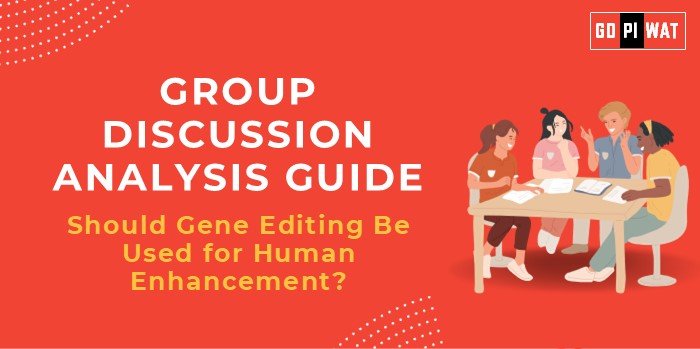🔬 GD Analysis Guide: Should Gene Editing Be Used for Human Enhancement?
🌟 Introduction to the Topic
- Opening Context: “Gene editing, particularly through technologies like CRISPR-Cas9, has revolutionized our ability to modify genetic material, offering unprecedented opportunities for medical advancements and human enhancement.”
- Background: Since the development of CRISPR-Cas9 in 2012, gene editing has rapidly progressed from theoretical research to practical applications, including the treatment of genetic disorders and potential human enhancement.
📊 Quick Facts and Key Statistics
- 🧬 CRISPR-Cas9 Discovery: Developed in 2012, CRISPR-Cas9 has become a cornerstone of genetic research.
- 📈 Global Gene Editing Market: Projected to reach $7.59 billion by 2029, growing at a CAGR of 10.2% from 2024. (Source: PR Newswire)
- 🩺 Clinical Trials: As of 2024, numerous trials explore gene editing for various applications, including human enhancement.
- ⚖️ Ethical Perspectives: A significant portion of the scientific community advocates for stringent regulations to prevent misuse.
👥 Stakeholders and Their Roles
- 🏛️ Governments: Regulate research and applications, ensuring ethical standards are upheld.
- 💊 Biotechnology Companies: Develop and commercialize gene-editing technologies.
- 🏥 Healthcare Providers: Implement gene-editing therapies in clinical settings.
- 🧑⚖️ Ethicists and Advocacy Groups: Monitor ethical implications and advocate for responsible use.
- 👨👩👧👦 General Public: Engage in discourse and influence policy through societal norms and values.
🏆 Achievements and Challenges
✨ Achievements
- 🔬 Medical Advancements: Gene editing shows promise in treating disorders like sickle cell disease and beta-thalassemia. (Source: Wired)
- 🧠 Research Progress: Significant strides in understanding gene functions and potential enhancements.
- 💰 Economic Growth: The sector attracts substantial investments, fostering innovation and job creation.
⚠️ Challenges
- ⚖️ Ethical Dilemmas: Concerns about eugenics, consent, and the moral implications of human enhancement.
- 🛠️ Safety Concerns: Potential off-target effects and unintended consequences of gene editing.
- 🌍 Regulatory Hurdles: Variations in international regulations create challenges for global research and application.
🌎 Global Comparisons
- 🇨🇳 China: Leading in gene editing research but facing ethical scrutiny over controversial experiments.
- 🇪🇺 European Union: Adopts a cautious approach with stringent regulations to ensure ethical compliance.
📖 Case Studies
- 🍼 CRISPR Babies Controversy: In 2018, a Chinese scientist claimed to have created the first gene-edited babies, sparking global ethical debates and regulatory crackdowns.
- 🩺 Sickle Cell Disease Treatment: Recent clinical trials successfully used gene editing to treat patients, marking a significant milestone. (Source: Wired)
💬 Structured Arguments for Discussion
- ✔️ Supporting Stance: “Utilizing gene editing for human enhancement can lead to improved health outcomes and the eradication of genetic diseases, significantly benefiting society.”
- ❌ Opposing Stance: “Human enhancement through gene editing poses ethical risks, including potential social inequality and unforeseen genetic consequences.”
- ⚖️ Balanced Perspective: “While gene editing offers remarkable potential for human enhancement, it necessitates careful ethical consideration and robust regulatory frameworks to mitigate risks.”
🔍 Effective Discussion Approaches
📜 Opening Approaches
- 📖 Historical Context: “Since the advent of CRISPR-Cas9 in 2012, gene editing has transformed from a scientific concept to a tool with profound implications for human health and enhancement.”
- 🤔 Ethical Inquiry: “As we gain the power to edit human genes, we must confront the ethical question: Should we enhance human capabilities beyond their natural state?”
💡 Counter-Argument Handling
- 🛠️ Safety Concerns: “Ongoing research and clinical trials are continually improving the precision and reliability of gene-editing technologies.”
- ⚖️ Ethical Issues: “Establishing comprehensive ethical guidelines and engaging in public discourse can address moral concerns associated with human enhancement.”
🔎 Strategic Analysis of Strengths and Weaknesses
- 💪 Strengths: Potential to eliminate genetic disorders; advancement in medical research and therapies; economic growth through biotech innovation.
- ⚡ Weaknesses: Ethical and moral controversies; risk of unintended genetic consequences; high costs limiting accessibility.
- 🌱 Opportunities: Development of personalized medicine; enhancement of human capabilities; leadership in global biotech innovation.
- 🌩️ Threats: Potential misuse for ‘designer babies’; widening social inequality due to access disparities; international regulatory conflicts.
📈 Connecting with B-School Applications
- 🔬 Real-World Applications: Exploring commercialization of gene-editing technologies, ethical business practices in biotech, and the impact of innovation on healthcare markets.
- ❓ Sample Interview Questions:
- “How can businesses balance innovation in gene editing with ethical responsibilities?”
- “What role should regulatory bodies play in overseeing the commercialization of gene-editing technologies?”
- 💡 Insights for Students: Understanding the intersection of biotechnology and business ethics, regulatory compliance, and potential market opportunities in biotech.


